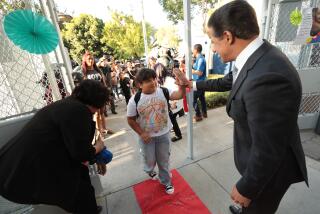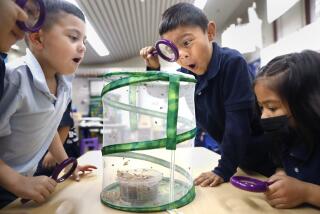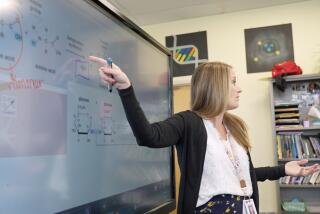Classes for Teachers Return to Basics, Especially Math
- Share via
LAKE ELSINORE, Calif. — They dart into class at Temescal Canyon High as much as 30 minutes late, downing chips, sodas or even a burger from the fast-food joint down the street.
Rebellious teenagers?
Wrong. Try teachers, fitting in a snack as they race between the end of a full day teaching and the start of a no-breaks, 3 1/2-hour session as students. Tonight’s topics: math functions, linear equations, graphing parabolas, even some dreaded word problems.
In short, introductory algebra. That is what sets this class, one of dozens occurring this summer across California, apart. Most professional development classes for teachers have focused on teaching tricks--how to get kids to teach one another or a snazzy new way to liven up classroom discussions.
But there’s little evidence, researchers now say, that the billions of dollars spent on pushing such generic teaching techniques have had much, if any, impact on student achievement.
Now, a nationwide movement to raise academic standards is creating an appreciation for a sometimes neglected truism--you can’t teach what you don’t know. And in the case of elementary and middle school teachers, what they often don’t know very well is mathematics.
Most state-approved teacher preparation programs in California only require those who want to teach in elementary and, under some circumstances, middle schools, to take two classes, neither involving college-level math. An alternative route involves taking a test, the math part of which has 24 mostly arithmetic questions and for which teachers can use a calculator.
“Math was like a phobia” starting as early as grade school, said Diana Clemente, now a third-grade teacher who admits that the algebra class at Temescal Canyon has been “more than challenging.” In college, she put off taking math until her last semester. Even then, she took a special statistics class for teachers instead of a true college math class.
With key concepts of algebra, such as the use of variables, now being taught as early as the third grade, she is finally confronting her fear of numbers. Clemente is midway through 125 hours of instruction in algebra and geometry, squeezing homework and test preparation around her regular workload of planning lessons and grading students’ work.
Across the nation, thousands of teachers are making similar efforts to relearn, or learn for the first time, the subjects they teach.
Experts have long bemoaned the fact that many high school teachers are unprepared, but only recently have they begun to recognize the impact of teachers’ limited subject knowledge in elementary and middle school.
“The problem of how to strengthen teacher content knowledge is becoming front and center as states think about what are the principal barriers they face as they actually try to implement these standards,” said Robert Schwartz, the president of Achieve Inc., a Boston-based group set up by governors and business leaders to push for higher academic standards nationally.
Merely knowing nuclear physics, educators say, doesn’t guarantee that you can teach it to someone else, especially to children. But without a deep knowledge of even the simplest subjects, such as arithmetic, it’s impossible to detect flaws in pupils’ understanding or to answer a question that isn’t covered in the teachers guide.
“You can design all the textbooks you want, but if teachers don’t understand the math, they probably aren’t going to be able to pull off the teaching,” said Deborah Loewenberg Ball, a University of Michigan education professor. She was among the first to document that most American elementary school teachers have trouble explaining something so basic as fractions.
Teachers Feel the Pressure
Although math is getting the most attention, states are upping the ante in science, social studies and language arts as well--for teachers as well as students. High school graduation tests and policies to end the “social promotion” of those who are unqualified are increasing the pressure for students.
Pressure on teachers is coming from states, such as Virginia, that have raised the passing score on teacher licensing exams. Massachusetts wants to test all teachers, not just those new to the field, to make sure they know their subjects.
To make sure they understand what they’re to teach, elementary school teachers in Pittsburgh spend one Saturday a month reviewing topics such as place value and how to divide fractions. “We walk through the units, lesson by lesson,” said Diane Briars, head of mathematics for the district.
Last year, U.S. Secretary of Education Richard W. Riley blamed the nation’s weak showing on international comparisons of math and science on the lack of expertise of many American teachers in their subjects.
Reflecting such concerns, California moved to write “world-class” standards of its own.
Statewide test scores released recently show how far California’s students have to go to measure up to the new expectations. Overall, students scored near the national average on the main math portion of the Stanford 9 skills test. But students also were asked more challenging questions based on the new standards--and they were clearly overmatched, answering between 40% and 50% correctly, depending on the grade.
By the time they graduate, students are supposed to have taken two years of algebra and one of geometry.
Supposed to, perhaps, but many schools won’t be able to provide those courses--at least not with teachers who are able to do little more than stay a page or two ahead of students in the textbook. According to the California Commission on Teacher Credentialing, the state needs 5,000 additional math teachers.
In the Los Angeles Unified School District, one in five math teachers are working under emergency permits, meaning they are not fully trained. District officials say the ratio of prepared teachers to students will get even worse soon, the unintended consequence of class-size reductions for ninth-graders.
Even as California recruiters scout the country for teacher prospects to fill those slots, the state is trying to address the shortage by offering tuition loans to those with math backgrounds who want to take up teaching. For current teachers, public colleges are running summer sessions, with follow-ups during the school year, in such topics as number theory, geometry, probability and statistics as well as algebra.
Furthermore, the state has set aside $30 million to pay for teachers to take college-level math classes designed to prepare them to teach math in specialized classes in grades six, seven and eight, where state officials believe the standards will require the greatest and quickest adjustment.
Seventeen campuses in the Cal State system are working on programs such as the one at Temescal Canyon, which is organized by Cal State San Bernardino in conjunction with local school districts. That campus’ “mathematics preparation initiative” has enrolled 53 teachers as “students” at three different sites.
Math professors and education professors--two groups that rarely see eye to eye on what makes for good teacher preparation--worked together to develop the content of the classes.
At the same time they’re learning math, the teachers are gaining confidence to teach in a new, more in-depth way, engaging their students in discussions of mathematical concepts rather than simply ordering them to memorize rules.
But even some of those involved in such efforts worry that they’re not enough to make a difference. “We’re doing stopgap stuff; we’re trying to patch up for the short term,” said Peter Tannenbaum, a math professor at Cal State Fresno who has 70 elementary and middle school teachers in his two algebra classes, which meet five days a week for five weeks.
Changing the Certification Method
The barriers to doing more seem steep. The state has cut back on the professional development time it pays for, to three days a year. The financial incentive for teachers to take such classes is paltry: The teachers at Temescal Canyon will net only $100 after paying for tuition and books, although the classes may qualify them for higher salaries.
The larger solution, experts say, is an overhaul of how teachers, starting with those who plan to work in elementary schools, are trained and certified. California officials currently are trying to align the training of teachers and the tests they have to take with the state’s new standards, but they are wary of simply pushing more college courses.
“Many college math departments begin with calculus,” said Dennis Tierney of the California Commission on Teacher Credentialing. But teachers need to understand far more basic concepts.
Victor Zupancich, a 54-year-old sixth-grade teacher at Bloomington Middle School in San Bernardino, said the Cal State San Bernardino program “definitely has made me a better teacher.”
Recently, he taught a lesson involving the square root of 2 to his sixth-graders, a topic he’s never brought up before. In the process, his students had to use number lines, got a new perspective on multiplication and even were introduced to the abstract concept of imaginary numbers.
Without the refresher, though, he’d never have attempted it. “The last time I had the math we’re using was in 1962 and 1963,” he said.
The best lesson, though, might have been the one he and his fellow teachers learned about what it’s like to struggle with difficult material. “Boy, it has really helped me sympathize with the kids and what they’re going through,” he said.
More to Read
Sign up for Essential California
The most important California stories and recommendations in your inbox every morning.
You may occasionally receive promotional content from the Los Angeles Times.










